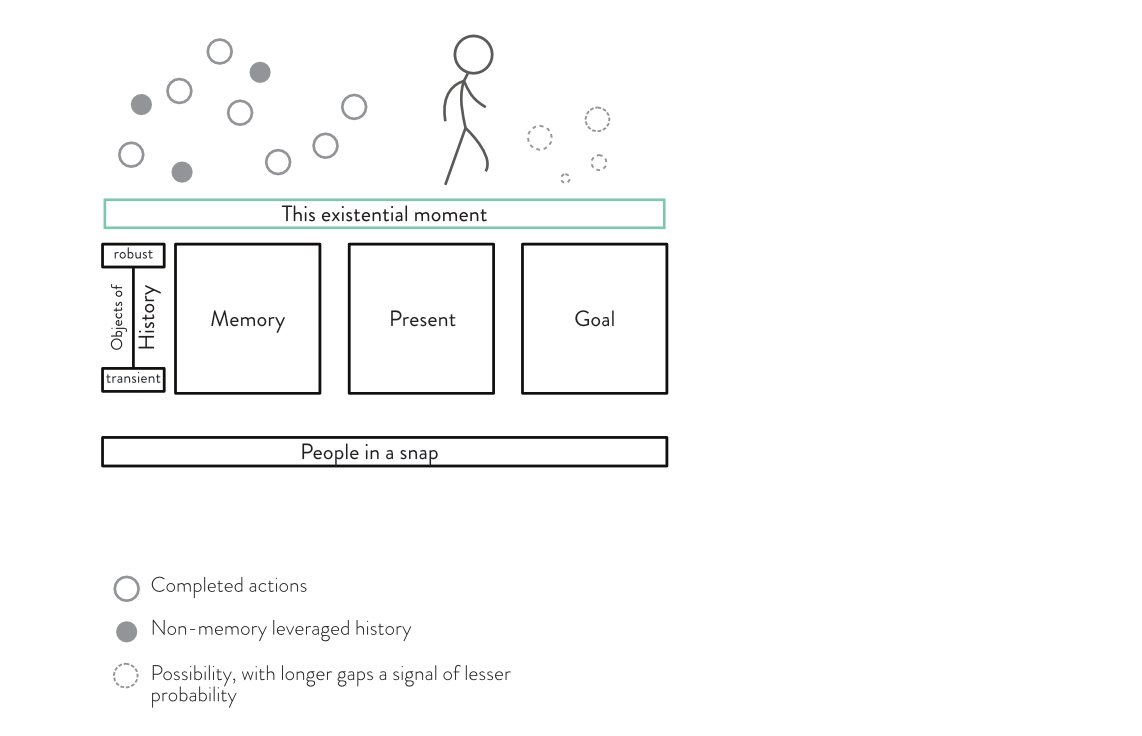Non-memory history: tools
People leveraging objects from outside the snap
We don’t have to dig that far into our histories to find when the only information we have are things left by those who came before: paths (which could also be non-human fauna), buildings, furniture, pots, clothing. As time continued it’s trudge forward, we added writing: our first information technology.
These are all tools. Tool are embedded with implicit information, ways to extend what we already have and know. They are (to date mostly physicalized) forms of encapsulated rich data.
Some of those things last millennia (stone buildings), some rot and return to the earth in a matter of months if they aren’t cared for (clothing). But they are still tangible pieces of the past that can be seen and used in time beyond their source.
As we’ve developed tools, we’ve added incredible depth and breadth to the available input from the past. We have rich sound recordings on various media. We have visual recordings that are a precise, non-interpretive reflection of reality. They are still only pieces; there will still be things happening outside of the capture of sound waves or the frame of the lens. But what they’ve captured is a richer, more nuanced form of the past brought to the now than we had before.
In terms of data points? Our available data is so rich, so varied, so subject to interpretations that I wrote over 50 pages as a very basic introduction to how they can be pulled together. Many of us mostly depend on our information technology and libraries to manage it.
The data contained in digital information technology can even be interpreted by a program. If it's looked at as only the lens of immediate experience, it has no learning curve, no ideating, no memory needed. Simply pop in parameters, and solutions spit out. But the tools are embedded with richer data than our hammers and pots. It has learning, just not yours. It has ideating, just from someone so far away from you that you can't even imagine who they might be. It has memory, but across all the databases it can leverage -- and which is predicated on someone else entering it, applying metadata, creating the fields for metadata, and building it in software on hardware that they know how to develop to eventually get it to an unknown user. Now think about information and who-ness, and that's likely more trust than most people give their spouse.
The data in our digital information technology is also, possibly, transient. It has only one form of access (electronic) even if the interface and tools are getting richer. If we lose our electric technology, none of these histories will survive. They will be lost quicker than a shirt left in the woods.
Technically, because we’re always using tools we already have, those objects of history are part of people in a snap. Technically, because tools are always built according to what is already-understood, they are predicated on bets and finite information formulated from history.
bet, encapsulated rich data, ideation, learning, memory
Goman, C. K. (2011, November 28). How culture controls communication. Forbes. https://www.forbes.com/sites/carolkinseygoman/2011/11/28/how-culture-controls-communication/
Wikipedia contributors. History of writing. Wikipedia, The Free Encyclopedia. https://en.wikipedia.org/w/index.php?title=History_of_writing&oldid=1286978982
...tools are embedded with implicit information...
The British Museum. (2024, August 1). The Babylonian Map of the World with Irving Finkel | Curator’s Corner S9 Ep5. Youtu.Be. https://youtu.be/LUxFzh8r384?si=YbhmrEFvju-aE17Y
Frederickson, E. (2025, May 1). Archaeologists found 11,500-year-old tools that reveal an incredible human adventure. Popular Mechanics. https://www.popularmechanics.com/science/archaeology/a64635154/scotland-tools/
Devlin, H. (2023, February 9). Discovery of 3m-year-old stone tools sparks prehistoric whodunnit. Theguardian.com. https://www.theguardian.com/science/2023/feb/09/discovery-ancient-stone-tools-prehistoric-mystery-whodunnit
The British Museum. (2024a, June 13). We found a lost temple using maths sent by an ancient Sumerian god. https://youtu.be/WctTJVdsISE?si=CHoWcRNW8IH08YHP
